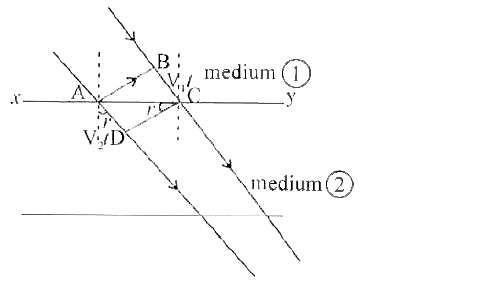Using Huygen's wave theory of light , derive Snell's law of refraction.
Text Solution

Let xy represent the surface separating medium (1) and medium (2) as shown in the figure. Let v1 and v2 represent the speed of light in mediums (1) and (2) respectively.
A plane wave front incident on the interface xy at angle i. Let t be the time taken by the wavefront to travel the distance BC. then BC=vit.
The secondary wave from A will travel a distance V2t in medium 2 , in the same time period. Draw an arc in medium 2. Then AD=V2t and the tangent from C touches the arc at D . CD is the tangential surface touching all the spheres of refracted secondary wavelets , and hence CD is the refracted wave front.
∠(BAC)=i and ∠(DCA)=r
From triangle BAC, sin i = BCAC
From triangle DCA, sin r =ADAC
(sin i)/(sin r) =(BC//cancel(AC))/(AD//cancel(AC))
=BCAD
Substituting values of BC and AD ,
therefore (sin i)/(sin r) =(V_1 cancelt)/(V_2 cancelt)=V_1/V_2 to (1)
Now, R.I of the first medium V1=c/n1
Similarly for the second medium V2=c/n2
Substituting in eqn.(1) , we get
(sin i)/(sin r) =(cancelc//n_1)/(cancelc//n_2)=(1//n_1)/(1//n_2)=n_2/n_1
∴sinisinr=n1n2
This is the snell.s law of refraction.
|
Updated on:21/07/2023
Related Playlists
Similar Questions
Define Snell's law of refraction.
View SolutionDefine the term wavefront. Using Huygens' wave theory, verify the laws of reflection.
View SolutionHuygens wave theory is used
View SolutionHuygen's wave theory of light cannot explain
View SolutionHuygen's wave theory of light could not explain
View SolutionOn the basis of Huygen.s wave theory, prove Snell.s law of refraction of light. Draw a neat and labelled diagram. (Postulates of Huygen.s wave theory not required)
View SolutionOn the basis of Huygen.s wave theory, prove Snell.s law of refraction of light. Draw a neat and labelled diagram. (Postulates of Huygen.s wave theory not required)
View SolutionHuygen's wave theory of light could not explain
View SolutionHuygen's wave theory of light could not explain
View SolutionUsing Huygens' principle for the wave theory of light, verify the law of refraction.
View Solution

